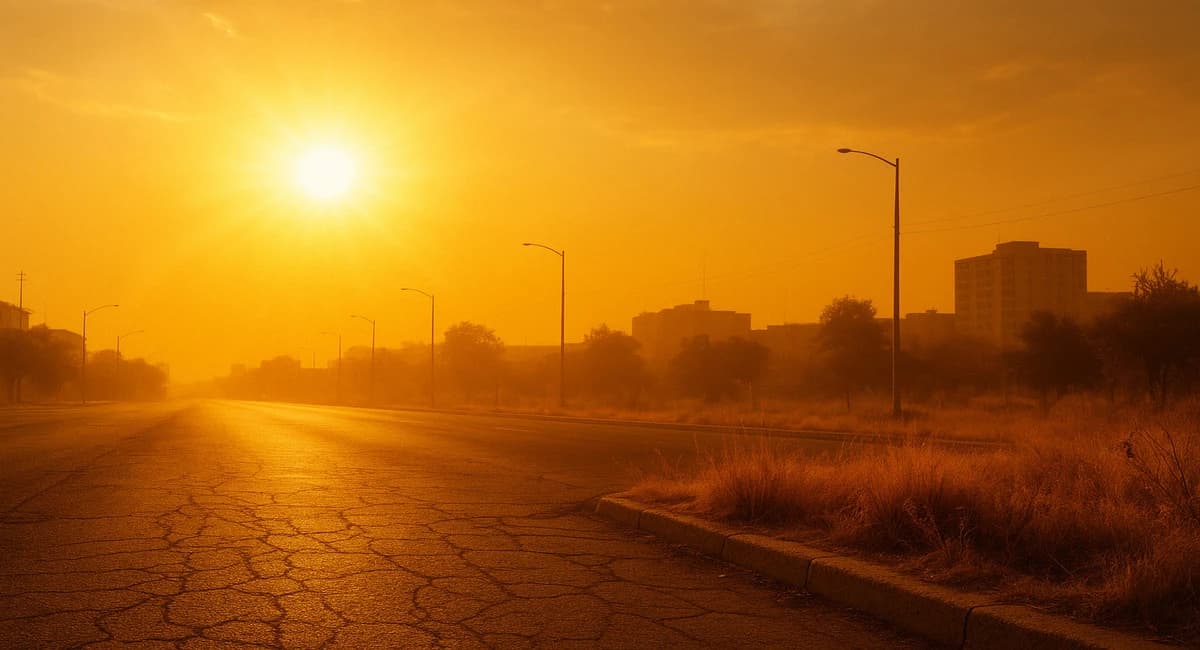© 2025 Roz UpdatesbyTETRA SEVEN

* All product/brand names, logos, and trademarks are property of their respective owners.
In May 2025, Pakistan is confronting one of the most punishing heatwaves in its recorded history. The Pakistan Meteorological Department (PMD) has issued red alerts for multiple regions, with temperatures soaring as high as 50°C in parts of Sindh and Southern Punjab. From Jacobabad to Multan, the blistering heat is not just uncomfortable—it’s dangerous, even life-threatening.
This extreme weather event, which meteorologists describe as “4 to 7 degrees Celsius above seasonal norms,” is affecting millions. Schools have shortened or suspended classes, businesses are operating on reduced hours, and outdoor laborers are being urged to stay home as the risk of heatstroke and dehydration climbs. Major urban hubs like Karachi, Lahore, and Islamabad are reporting record-breaking daytime highs, while rural regions with less infrastructure are grappling with minimal access to cooling or medical relief.
Officials from the National Disaster Management Authority (NDMA) and Provincial Disaster Management Authorities (PDMAs) have launched emergency protocols, warning that the heat will intensify before easing off. Citizens are being asked to avoid outdoor activities between 11 AM and 4 PM, drink plenty of fluids, and stay indoors as much as possible.
What makes this year’s heatwave particularly alarming is not just the intensity, but its duration and geographical spread. Experts are also linking it to broader patterns of climate change and global warming, underscoring a stark reminder of the environmental vulnerabilities Pakistan faces. According to recent climate models, such extreme weather patterns are likely to become more frequent and more severe if greenhouse gas emissions remain unchecked.
In this guide, we provide a comprehensive, city-wise breakdown of heat levels across Pakistan, and an actionable safety guide tailored for individuals, families, and communities. Whether you’re in the heart of Karachi or a village in Southern Punjab, this article aims to keep you informed and protected during this unprecedented crisis.
As the 2025 heatwave sweeps across Pakistan, temperature records are being shattered in both major cities and rural regions. Below is a breakdown of the most severely impacted areas, categorized by region. This data has been compiled using PMD alerts and media reports issued between May 15–20, 2025.
| City | Max Temp (°C) | Alert Level | Notes |
|---|---|---|---|
| Jacobabad | 49.5°C | 🔴 Red | Among hottest globally |
| Dadu | 48.8°C | 🔴 Red | High humidity impact |
| Nawabshah | 48.2°C | 🔴 Red | Blackouts worsening risk |
| Mohenjo-Daro | 47.7°C | 🔴 Red | Museum cooling needs critical |
| Larkana | 47.3°C | 🔴 Red | Limited water supply |
| Hyderabad | 44.9°C | 🔴 Red | Urban poor highly exposed |
| City | Max Temp (°C) | Alert Level | Notes |
|---|---|---|---|
| Multan | 46.5°C | 🔴 Red | Crops at risk |
| Bahawalpur | 46.1°C | 🔴 Red | Heat-related school closures |
| Rahim Yar Khan | 45.8°C | 🔴 Red | Hospitals report spike in dehydration |
| DG Khan | 45.2°C | 🔴 Red | Laborers advised to rest indoors |
| City | Max Temp (°C) | Alert Level | Notes |
|---|---|---|---|
| Lahore | 43.5°C | 🔴 Red | AQI worsened; asthma concerns |
| Faisalabad | 42.7°C | 🔴 Red | Factories working reduced shifts |
| Gujranwala | 42.0°C | 🔴 Red | Public transport under pressure |
| Sialkot | 41.5°C | 🔴 Red | Few cooling shelters available |
| Rawalpindi | 41.2°C | 🔴 Red | Evening temperatures remain high |
| City | Max Temp (°C) | Alert Level | Notes |
|---|---|---|---|
| Peshawar | 43.3°C | 🔴 Red | Red alert sustained since May 16 |
| DI Khan | 44.1°C | 🔴 Red | Water trucks deployed by PDMA |
| Bannu | 42.8°C | 🔴 Red | Healthcare strain in rural clinics |
| Mardan | 41.4°C | 🔴 Red | Schools operating half-day |
| City | Max Temp (°C) | Alert Level | Notes |
|---|---|---|---|
| Sibi | 47.0°C | 🔴 Red | Power outages daily |
| Turbat | 46.6°C | 🔴 Red | Lowest rainfall in 6 months |
| Quetta | 39.2°C | 🟠 Orange | Unusual for elevation; low water |
| City | Max Temp (°C) | Alert Level | Notes |
|---|---|---|---|
| Muzaffarabad | 36.4°C | 🟡 Yellow | Heat risk rising |
| Gilgit | 33.5°C | 🟢 Green | Safe zone, but glacier melt risk up |
| Skardu | 31.2°C | 🟢 Green | Noticeable warming trend |
As temperatures continue to soar beyond 50°C in parts of Pakistan, safety is no longer optional—it's critical. Whether you’re in an urban apartment or a rural village, following these survival strategies can mean the difference between resilience and crisis.
Hydration is your frontline defense. Adults should aim for at least 3–4 liters of water daily, even if they don't feel thirsty. Avoid sugary drinks, caffeine, and alcohol. If possible, keep ORS (Oral Rehydration Salts) handy, especially for children and the elderly.
Stay indoors between 11 AM and 4 PM, the hottest part of the day. If you must be outside, wear loose, light-colored clothing, sunglasses, and a wide-brimmed hat. Apply sunscreen (SPF 30+) and take frequent breaks in shaded areas.
Watch for heatstroke symptoms: dizziness, confusion, nausea, excessive sweating or complete lack of sweat, and rapid heartbeat. If these signs occur, move the person to a cooler place immediately, offer water, and seek medical help.
If you lack access to air conditioning, create DIY cooling systems:
Hang wet sheets in windows to create evaporative coolers.
Use ceiling fans in conjunction with open windows for cross-ventilation.
Keep curtains and blinds shut during peak sun.
Children under 5, the elderly, and those with chronic conditions (e.g., heart disease, asthma) are most at risk. Never leave anyone—including pets—in a parked vehicle, even for a few minutes.
Local Tip (Punjab/Sindh): Use traditional clay "matkas" to store drinking water. They're naturally cooler and safer than plastic bottles left in heat.
The NDMA and PDMA have activated Heatwave Response SOPs, which include:
Establishing Cooling Shelters in mosques, schools, and community halls.
Mobile medical teams in high-risk zones like Bahawalpur and Jacobabad.
Public awareness campaigns via local radio, TV, and mosque announcements.
In urban zones like Karachi and Lahore, water distribution points are being set up near markets and bus stops. Citizens are urged to assist by checking on elderly neighbors and sharing shade and water when possible.
Emergency Hotlines:
PMD Alert Line: 131
NDMA Emergency Helpline: 1122
Provincial Disaster Authorities (PDMA) – vary by region
Staying alert, prepared, and community-minded can significantly reduce the risk of casualties. The next few days are crucial—your actions can protect your household and your neighborhood.
The 2025 heatwave has plunged Pakistan into one of the most challenging climate emergencies in its recent history. With over 40 cities facing red alerts, and temperatures breaching the critical 50°C mark, the country stands at a pivotal moment—one that tests not just our resilience, but our preparedness and unity.
From the sun-scorched plains of Sindh to the densely populated neighborhoods of Punjab, no region is untouched. Yet, this is not just a story of crisis—it's also a call to action. Government agencies, media, and communities are stepping up: activating relief shelters, issuing safety bulletins, and checking in on the most vulnerable among us. But institutional response alone is not enough.
Each of us holds power. Power to protect a neighbor by offering water. To shelter an outdoor worker with shade. To educate a family member about the early signs of heatstroke. These acts, though small, save lives.
As we brace for more hot days ahead, it’s critical to stay updated via PMD advisories, follow NDMA alerts, and share this guide within your circles. Climate extremes are becoming more frequent, and public awareness is our first line of defense.
So let’s not wait for another tragedy to wake us up. Stay indoors, stay hydrated, and most importantly—stay connected.
Together, we can weather this wave.

9 October 2025

23 September 2025
No comments yet. Be the first to comment!